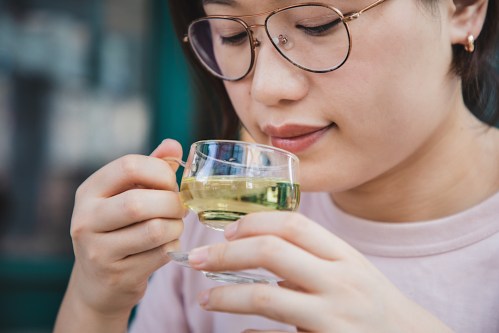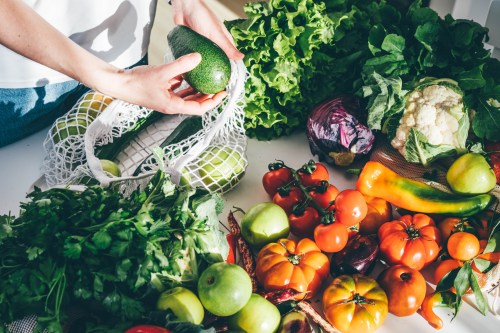Chrysanthemum Tea’s Benefits, Background, and Best Brewing Practices, According to Traditional Chinese Medicine Experts
Traditional Chinese medicine experts and herbalists explain the benefits, background, and best brewing practices of chrysanthemum tea.

I grew up drinking flowers, or, more specifically, chrysanthemum tea. I’d watch the blossoms bloom in hot water, their crinkly dull bodies expanding to reveal centers that brightened back to yellow before going murky gray as their color transferred to the tea, tinging it the faintest grassy green.
Experts in This Article
Shunan Teng is the founder and CEO of Tea Drunk
Thomas Leung, DACM, LAc, owner of Kamwo Meridian Herbs and a fourth-generation herbalist.
Acupuncturist and TCM practitioner Tsao-Lin Moy, LAc, is the founder of Integrative Healing Arts.
Zoey Xinyi Gong, is a TCM chef and food therapist
Petals would sometimes escape to my cup as my mother poured the sunny liquid through our makeshift strainer—a sieve that floated over a big glass Pyrex capped off with one of the tin camping plates we so often used in our Chinese-American home because it was all-purpose, durable, lightweight, unbreakable, and most importantly, steamable. I’d pick them off my lips or tongue, oversaturated now, all gummy, pale, and dejected, as I savored the warmth of my mug through my hands. The light, fragrant aroma of this mild tea, a barely perceptible bitterness, balanced by the few chunks of rock candy my mom always added to the pot that offered a subtle sweetness regular sugar would be too bold to provide, is as familiar a scent to me as any I know.
I think of my mother now as I drink a cup of chrysanthemum tea I made myself, albeit, with a more bougie setup: I use an ultra-fine mesh strainer built to fit in an overly fragile glass teapot—a modern convenience for a tea drank by Chinese people for thousands of years. It tastes like comfort to me, and I can feel myself calming down and cooling off with every sip.
In traditional Chinese medicine (TCM), it’s believed that food can have hot or cool properties. Consume too much with a “hot” essence like deep fried foods or red meat and your humours would be out of sorts, welcoming annoyances like canker sores, dryness, and the like. You need cooling foods to even things out in a yin and yang way; high water-content vegetables, fish, fruit…chrysanthemum tea.
I grew up taking for granted this sense of innate hot and cool properties and never thinking much of it when my mother would extoll the virtues of this casual beverage, but now I want a deeper understanding of this tea I’ve drank for decades, so I turned to formal practitioners of TCM and professional herbalists for a clearer picture of chrysanthemum tea, its history, benefits, and the best practices for buying and making it yourself.
History of chrysanthemum tea
A flower native to China, chrysanthemums are one of the most beloved blossoms to its people, solidified by their place as one of the country’s four “virtuous” or “noble” plants. In times of grief, white chrysanthemums convey love, purity, and remembrance. In other times, they symbolize longevity and the fall, as they are autumnal blooms that offer vibrancy through frost, even as all other plants have dropped their blossoms.
For this reason, chrysanthemum tea is commonly drunk around the important Mid-Autumn Festival. Like so many Chinese folks around the world, Zoey Xinyi Gong, RD, a TCM chef, says she’ll usually steep a cup while enjoying her mooncakes under the fullest moon of the year.
The practice of drinking chrysanthemum tea dates back thousands of years and is a common and universal one in China, so ubiquitous that it’s been carried across seas and passed down through generations. “My uncles kept a transparent Thermos with them at all times,” says Gong. “Through the glass, I remember seeing chrysanthemums floating around with some goji berries,” Meanwhile, acupuncturist and TCM practitioner Tsao-Lin Moy, LAc, founder of Integrative Healing Arts, says drinking chrysanthemum tea with her father while eating dim sum in the summer as one of her fondest memories from childhood. Like my mother, Moy passed a taste for this tea down to her daughter. “When she was very little, I would make it and add bei mu gua lou syrup for when she had a sore throat and cough.”
There are multiple references from the Song Dynasty (an imperial Chinese dynasty that dates back to 960) of chrysanthemum tea, says Moy. “But this tea, common to Southern China, is much older than that, starting as a folk remedy or food, then being codified into medicinal use.” Tea Drunk founder and CEO Shunan Teng adds: “Its medicinal properties have been mentioned as early as in books written in the Han Dynasty, 202 BC–220 AD.”
Benefits of chrysanthemum tea
“In TCM, everything is about balancing yin and yang,” says Thomas Leung, DACM, LAc, owner of Kamwo Meridian Herbs and a fourth-generation herbalist. Throughout history in Chinese culture, foods and herbs have been assigned yin or yang properties—they’re either cooling (yin) or hot (yang). If you have too much yang, it manifests as heat. Unchecked, built-up heat encourages related symptoms: fever, infections, sores, red eyes. “Chrysanthemum tea is categorized as a heat-clearing tea, specifically for liver heat, to help restore balance,” Dr. Leung says.
Because of its “cooling” qualities, it’s a popular pick for people who tend to run physically hot, as well as Chinese women who may be experiencing hot flashes due to menopause, Moy says. Its caffeine-free nature is indicative of its yin properties, as are its antioxidant and immune-boosting benefits. Plus, scientifically, “studies show that chrysanthemum can help reduce inflammation and blood pressure, and extracts of chrysanthemum can help with osteoporosis,” Moy points out. “And generally, in TCM, flowers tend to treat head, sinus, and throat conditions.”
What does chrysanthemum tea taste like?
To Moy, “it’s similar to chamomile, but with a more delicate flavor.” (Teng agrees. “But sweeter and brighter,” she adds.) And Dr. Leung describes it as “pleasant; flowery, but not overpowering.” Gong also finds it refreshing and floral; however, she cautions that it can become bitter if you add too many blossoms to your brew.
But like many plants and herbs in China, chrysanthemums also value terroir, and the tea that comes from different parts of China can taste differently. “Wild chrysanthemum is believed to be more potent than cultivated varieties of the plant,” says Teng. “This is a difference of evolution. [Wild chrysanthemums] are grassier, have a minty touch, and can be bitter when brewed for long.
The mild flavor of chrysanthemum tea also lends itself well to combining with other teas, which is a common practice in TCM. “Herbs are not generally used singularly,” explains Dr. Leung. “They’re usually in combinations, even if it’s a simple one. With chrysanthemum, you can pair it with honeysuckle, which is also head-clearing. Combining it with prunella is also common—so much so that you’ll find it in 7-Elevens across China.”
Moy stands by the classic san ju yin formula, which includes mulberry leaf, forsythia, mint, and other herbs that soothe cough and fever. But in its simplest execution, the goji berries Gong mentioned earlier are also a go-to for many, my own mother included. “They work together really well to treat dry, red eyes, and liver fire conditions that many people have nowadays due to irregular sleep and busy work schedules.” Teng also suggests adding dried dates to the combo. “Goji and dates are good for warming the body and are popular among ladies in China,” she says. “When combined with chrysanthemum, it becomes a balanced drink.”
From a tasting standpoint, Teng shares that “the most-popular tea to be blended with chrysanthemum is pu er shou cha (shou pu), which is a true Chinese black tea,” as opposed to the red teas considered black by Western cultures. “Chrysanthemum’s brightness provides a great balance to the dark, earthy notes of a typical shou pu,” she explains.
How to choose quality chrysanthemum tea
Herbalists and TCM practitioners like to keep it simple. If it’s fresh and free of insects, Dr. Leung is happy doling it out, confident in its properties regardless of specific types. Moy opts for organic and looks for pops of bright yellow. “If possible, smell them—the scent should still be fresh,” she says.
Gong prefers to judge by sourcing. “It’s not always easy to tell if the chrysanthemums are good with naked eyes. While the darker, sad-looking ones may be too old, the very bright ones may contain sulfate as a preservative,” she warns.
As for varietals, her recommendation is to try different kinds to see how their subtleties may speak to you. “Try Tai, Hang White, Gong, Snow, and Golden Thread; these are common varieties,” she says.
Teng adds white and light yellow blossoms from Hang Zhou to the list. “It’s another top terroir chrysanthemum,” she says. But generally speaking, more important is the condition of the flowers. “A critical indicator is how open they are,” she says. “We don’t want already bloomed chrysanthemums; the best are the ones about to bloom but have really just ‘opened.’” You can identify them by their cute, spherical buds with petals just peeking out shyly from their tight, curled-up forms.
Personally, like Teng, I prefer the lighter colored ones, which appear fresher and whose cleanliness is easier to spot. If a batch is too dusty, discolored with gray, or have many loose petals strewn about, pass on picking them.
How to prepare and drink chrysanthemum tea
When I ask Leung if there were any ritualistic practices associated with chrysanthemum tea, he laughs good-naturedly and says, “The ritual of sipping tea? Tea ceremonies are for fancy tea, but they’re not really a ritual,” he says, “And chrysanthemum tea is common, everyday, like making your own lemonade or iced tea in the summer. Plus, it’s medicinal, so it’s not about ritual.”
Teng echoes that. “The drinking of chrysanthemum tea is very casual,” she says, and the fact that it’s considered so ties in strongly with the virtues it’s supposed to embody. “The flower is praised for its unassuming beauty and ‘self respect,’” she says. “It blooms after all the colorful flowers ‘finish competing’ in the summer and doesn’t ‘show off’ in any way. It’s a metaphor in many Chinese works of literature and art, and represents one’s resolution to not seek fame or other vain desires.”
And so, the best way to honor this 3,000-year-old, traditional Southern Chinese beverage—outside of the Chong Yang or Double Ninth Festival, the flower’s formal day of recognition—is to not honor it at all, further keeping with its cooling, pressure-relieving properties. Less to think or worry about, more to enjoy. I think we can all drink to that.
Oh hi! You look like someone who loves free workouts, discounts for cutting-edge wellness brands, and exclusive Well+Good content. Sign up for Well+, our online community of wellness insiders, and unlock your rewards instantly.
Sign Up for Our Daily Newsletter
Get all the latest in wellness, trends, food, fitness, beauty, and more delivered right to your inbox.
Got it, you've been added to our email list.










